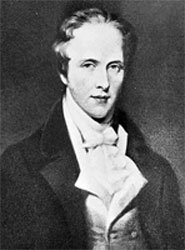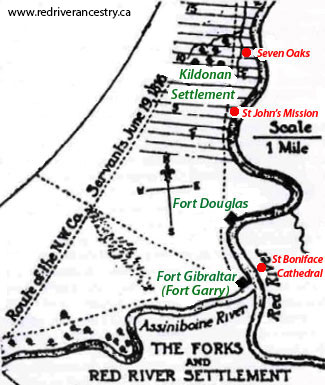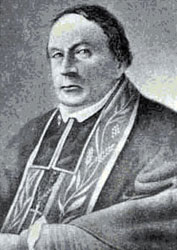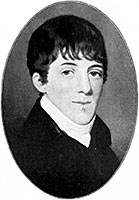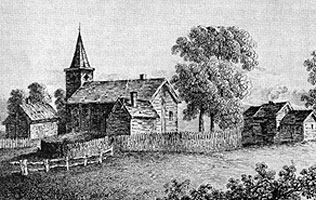THE FIRST RED RIVER CHURCHES AND SCHOOLS
Previous to 1812 the inhabitants of the Red River community were mostly of Indian, Métis and French origin; nomadic people who were primarily hunters, fishermen and fur traders. Some farming was undertaken at fur trading posts (gardens and livestock), but otherwise agriculture was almost non-existent.
There were no churches or schools. Marriages were mostly a la facon du pays (according to “the custom of the country”) or by contract. North West Company (NWC) and the Hudson’s Bay Company (HBC) employee records and journals often recorded such events. Occasionally baptisms and marriages took place when fur traders made trips to their homeland with their wives and/or children. On such occasions children were sometimes left behind with relatives or at residential schools to be educated.
THE SELKIRK SETTLERS
Thomas Douglas, Fifth Earl of Selkirk
Thomas DOUGLAS, the Fifth Earl of Selkirk (1771-1820) was born at Saint Mary's Isle, Kirkudbrightshire, Scotland. When Thomas inherited his father’s estate, he used his money and political connections to purchase land and settle poor Scottish (and Irish) farmers in Canada. In 1807 he was named Lord-Lieutenant of Kirkcudbright District in Scotland, thus he is usually referred to as Lord SELKIRK.
SELKIRK asked the British government for a land grant in the Red River Valley, a part of Rupert’s Land. The government refused, as the HBC had been granted a fur trading monopoly on that land. However SELKIRK was very determined, and he and Sir Alexander MACKENZIE (1764-1820) bought enough shares in the Company to let them gain control of the land. He called the region Assiniboia.
As part owner of the HBC, SELKIRK also wanted to stop the NWC from competing with the HBC for furs in the region. By placing the Red River Colony within the trade routes used by the NWC Coureurs des bois, he could cut off the easy flow of furs. However, the local Métis people who already inhabited the area had long-standing ties with the NWC, and refused to accept SELKIRK's control over the area.
By 1812 the first of Lord SELKIRK’s Settlers began to arrive, intent on beginning a permanent agricultural settlement. They were very fortunate to gain the support of Chief PEGUIS (1774-1864) and his band of Ojibwe Indians who came to their rescue on many occasions during their first difficult years.
In the fall of 1812, HBC surveyor Peter FIDLER (1769-1822) was sent to assist SELKIRK by surveying river lots. Lots were assigned to the settlers with a frontage on the Red River of 10 chains, extending from the north side of Point Douglas as far as Frog Plain, a little north of Old Kildonan. For his part in the affair, FIDLER and the settlers would soon suffer the wrath of Cuthbert GRANT (1769-1854), and his Métis soldiers.** MORE ABOUT PETER FIDLER
James “The Parson” SUTHERLAND
The necessity of providing certain spiritual oversight for his Scottish colonists occupied SELKIRK's mind. In 1815 James “The Parson” SUTHERLAND (1769-1828), an elder authorized by the Church of Scotland to baptize and marry, arrived with one of the bands of colonists at Red River. The first point in the agreement between SELKIRK and his colonists was "to have the services of a minister of their own church." This was SELKIRK's wish, and Mr. SUTHERLAND was sent as locum tenens. Even before his party reached the settlement, on Sep 4, 1815, SUTHERLAND had already performed his first marriage at York Factory; that of Christian BANNERMAN to Robert McKAY.
SUTHERLAND remained with his people through three years of great tribulation during which the NWC twice burned their homes, destroyed their effects and drove them from the settlement. Each time they returned, and with true Scottish courage and determination, made a new start.
The Beginning of the End for the North West Company
The settlers had already suffered several years of extreme hardship, enduring drought and starvation as well as harassment by the Métis and the NWC who had vigorously opposed their presence. Many years of bitter rivalry between the NWC and the HBC reached a climax on June 19, 1816 with the Battle of Seven Oaks at Frog Plain. Governor SEMPLE and twenty of his men were killed when Cuthbert GRANT and his Métis soldiers took Fort Douglas. The fort was destroyed and the settlers driven from their homes. Much has been written about the complex and controversial events and personalities of this period leading up to the union of the NWC and the HBC. I will only touch upon a few details pertinent to the arrival of the clergy.
In the last week of June, 1817, SELKIRK himself arrived at the Red River. He met his settlers on a spot a few yards south of the present St. John's Cathedral. Here he discussed their problems and here he set aside lots for their church and school. At this meeting his Lordship informed the settlers that but for the troubles at Red River, Mr. SAGE would have come out to minister to their religious needs, but he promised that they would have their minister without fail.
In accordance with his agreement he settled all of his De Meurons (disbanded soldiers of German, Swiss and Piedmontese origin) who wished to remain - a considerable number - along the banks of the little river, the Seine, which empties into Red River opposite Point Douglas. They were mostly of the Roman Catholic faith.
SELKIRK negotiated a Treaty with the Salteaux Indians (Chief PEGUIS). It was signed on July 18, 1817, granting them land (the St Peters Reserve) running north from Sugar Point (now Selkirk) to the mouth of the river at Lake Winnipeg.
SELKIRK departed from the settlement on Sep 9, 1817, and in 1818, James “the Parson” SUTHERLAND fell into the hands of agents of the NWC. He was forcibly carried off to Upper Canada, never more to return.
Establishment of the St Boniface Mission
Bishop Joseph-Norbert Provencher
Lord SELKIRK entered into correspondence with the Roman Catholic authorities in Lower Canada as to their appointing priests to minister to the needs of the French and De Meuron population of his colony. The two priests selected were Fathers PROVENCHER and DUMOULIN.
Joseph Norbert PROVENCHER (1787-1853) was born Feb 12, 1787 in Nicolet, Quebec, the son of a farmer. He was ordained priest on Dec 21, 1811.
Joseph Severe DUMOULIN (1793-1853) was born in Ste-Anne-de-Bellevue, Lower Canada. His father was Swiss and Protestant by origin, but he married as a Roman Catholic.
On July 16, 1818, Fathers PROVENCHER and DUMOULIN arrived in Assiniboia. With them came Guillaume (William) Etienne EDGE, a seminarian and a teacher. SELKIRK had set aside 25 acres for them east of the junction of the Red and Assiniboine rivers, opposite the site of the demolished Fort Gibraltar. Called St. Boniface Settlement, after the German patron saint, the settlers there were predominantly the German-speaking De Meuron soldiers who had been recruited by SELKIRK.
By far the most of their work would be with Catholic French speaking Métis families who were concentrated along the Assiniboine River as far west as Fort Qu’Appelle, and along the Red River, south to Fort Daer (Pembina). There was a lot of work to be done. In the first two weeks the clerics performed 72 baptisms.
On Sep 13, DUMOULIN went with EDGE to Pembina Territory, where he established a Catholic mission at Fort Daer. EDGE founded a school there.
On November 1, 1818, PROVENCHER built a small log building (20’ x 30’) in St Boniface that would serve as a residence. It also served as the first chapel and the first school west of the Great Lakes.
On Jan 5, 1819 DUMOULIN wrote from Pembina that EDGE was teaching 60 students.
In 1820 a larger log chapel was built, the first St Boniface Cathedral.
Lord SELKIRK became involved in litigations concerning lawsuits brought against him by the NWC. His health deteriorated and he died on Apr 8, 1820.
Reverend John WEST and the First St John’s Church and School
Reverend John West
Reverend John WEST (1778-1845) was born in Farnham, Surrey, England; the son of an Anglican clergyman. He was ordained in 1806, and in 1807 he married Harriet ATKINSON in Wethersfield, England. They had 12 children. In 1819, WEST became the first HBC chaplain appointed to Rupert’s Land.
By 1820 many years of bitter conflict between the HBC the NWC was reaching a climax. A merger between the two companies was imminent and it was obvious that staff reductions would have to be made when this happened. The Company’s plan was to expand the Red River settlement already created by Lord SELKIRK, to accommodate those HBC retirees who wished to remain in the country. Retirees from both companies, orphaned mixed-blood children, and others associated with the Protestant community in the west would have their spiritual requirements met in Red River. Schools, religious instruction, and pastoral care would be established there under the encouragement and aid of the Church Missionary Society (CMS).
On May 27, 1820, leaving his wife and children behind, WEST, with a trained schoolmaster named George HARBRIDGE, sailed for Rupert’s Land. On Aug 13 they disembarked at York Factory. There, WEST wasted no time in recruiting his first student for the school he intended to build; one of the sons of WITHEWACAPO. Then, on Oct 4 at Norway House, on the way to Red River, he recruited a second boy, SAKACHUWESCUM (later Reverend Henry BUDD); the son of a Muskego Cree Indian of (BUDD) from York Factory and WASH-E-SOO-E’SQUEW (Agathas), the half-caste daughter of Matthew COCKING (1743-1799). On Oct 13 they made one more stop-over at Netley Creek, where they met the famous Saulteaux Chief PEGUIS. The next day they arrived at their destination where their first abode was the colony’s Fort Douglas.
Soon after their arrival, a log house was repaired about three miles below the fort, where HARBRIDGE took up his residence and began teaching from 20 to 25 children. WEST moved into the farm that belonged to the late Earl of SELKIRK. The NWC – HBC union did in fact take place in 1821, and soon after (Sir) George SIMPSON (1786-1860) took the reins as the Governor of Rupertsland.
WEST’s Trip to Brandon – Qu’Appelle
From his Journal, Jan 20, 1821: We started at sunrise (at Portage) - - We arrived at Brandon House, the Company’s provision post; and the next day, being Sunday, the servants were all assembled for divine worship at eleven o’clock: and we met again in the evening at six, where the next morning he married the officer of the post, and baptized his two children (This was John Richards McKAY) - - Before I left this post, I married two of the Company’s servants, and baptized 10 or 12 children.
The NWC – HBC union did in fact take place in 1821, and soon after (Sir) George SIMPSON(1786-1860) took the reins as the Governor of Rupertsland. ** MORE ABOUT GOVERNOR GEORGE SIMPSON
On June 20, 1822 WEST stated in his journal “On our (he and an HBC Director) return (from Pembina), I took the opportunity of opening, with divine service, the building (though it was not finished) which was intended as a school-house, and a temporary place for divine worship; and at the same time, baptized two of the boys who had been under my charge, one, WITHEWACAPO, was baptised as James HOPE, and the other, SAKACHUWESCUM as Henry BUDD; they being able to read the New Testament, repeat the Church Catechism, and to understand the chief truths of the Christian Religion”.
In the fall of 1822 the HBC withdrew the priests from Pembina, for the reason that they now recognized that it was on the American side of the border. Some of the settlers then founded the Parish of St Francois Xavier, and others went to Fort Snelling and other points in the USA. Heart-broken, DUMOULIN returned to Lower Canada.
Once a settlement was established on Red River many flocked to it. Included were Highlanders, De Meurons (Swiss and German), French voyageurs, Metis, English and Orkney half-breeds; not less than fifteen hundred settlers. By this time there were settlers all along the river, as far north as “The Rapids” (later St Andrews) and Sugar Point (later Selkirk) WEST distributed copies of the Bible in English, Gaelic. German, Danish, Italian, and French, and they were all gratefully received in this polyglot community.
On June 2, 1823 WEST stated in his journal “I have been adding two small houses to the Church Mission School, as separate sleeping apartments for the Indian children, who have already made most encouraging progress in reading and a few of them in writing.
Rev John West’s first Church & School at Kildonan
On June 8, 1823, his last day in Red River, WEST baptised three of his Indian students: John HOPE, James HARBRIDGE and Charles PRATT (Boon).
On Aug 19, 1823 Rev John WEST arrived at York Factory on his way to England, having completed an arduous journey from York to Churchill and then back to York (180 miles both ways, walking). He would later relate his brief encounter with Reverend David JONES (1796-1844), the newly-ordained CMS deacon, selected to relieve him in Red River for a year. WEST wrote in his journal: “Here I had the happiness of meeting the Reverend David JONES, arrived by ship, on his way to Red River, my fellow-labourer in that situation; to whom I committed the two Chipewyan Indian boys. ** MORE ABOUT REVEREND DAVID JONES in DCBO After a few days, JONES proceeded with his little charge to his destination. One of the boys would later be named Thomas HASSALL (1811-1846). The other may have been Johnny OIG (1817-1889).
PROVENCHER was forced to recall DUMOULIN from Pembina in 1823. Unhappy with this decision, DUMOULIN sought permission to return to Lower Canada and, despite the disappointment of PROVENCHER and PLESSIS, he left the northwest in 1823 to the regret of his converts.
WEST failed to win the support of the new Governor, George SIMPSON, who thought he was spending too much time catering to the Indians, to the neglect of the HBC retirees who also began to view him in disfavour. Early in 1824, his employment was terminated by the London committee and he would never more return to Red River.
** As further details are uncovered, or when corrections are necessary, further revisions will be made. I plan to add more details about notable marriages and baptisms performed during the period discussed here, and about some of the notable students at these schools. I look forward to discussions and queries that will help me present the most accurate and interesting information possible. Please post comments and queries at this link: FORUM DISCUSSING THE FIRST RED RIVER CLERGYMEN, CHURCHES AND SCHOOLS
|

